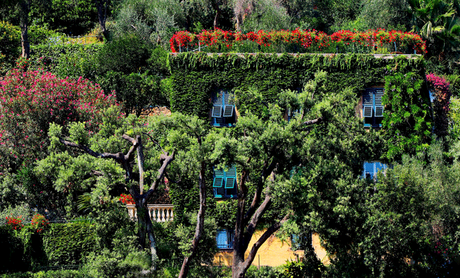
You may not have the millions required to install a putting green on a helipad but you can still find inspiration from famous gardens all over the world. Here are some ideas you can steal and make your own, regardless of the size of your garden.
- Use green living fences
"Good fences don't make good neighbours," as the saying goes. There are better ideas of creating boundaries within and around your property without resorting to permanent structures such as gates, walls or fences. One is the use of organic borders.
Organic borders may come in a variety of forms. You can use hedges, shrubs, and even trees as green fences. As they grow and mature, you can observe a change in the look of your garden. Living fences can create private enclosures while still making your garden appear inviting and attractive to guests and passersby.
Gardens all over the world are taking this more organic approach to separate areas. The Laden Café in Berlin, Germany features raised garden beds around dining areas.
With this idea, guests can easily walk a few steps and grab some of the fruits and vegetables nearby. Not only do they create private spaces, but the fences and the rest of your design also make great conversation topics.
- Garden like the French do
French intensive gardening is a technique which maximizes the use of space. With this gardening method, different types of plants are planted together.
The careful selection of plants allows each type to support the growth of the surrounding vegetation. As a result, efficiency is enhanced while the need for irrigation is reduced.
The Slide Ranch north of San Francisco, California utilizes this approach. In this garden, you can find both edibles and ornamentals planted right next to each other.
- Use edible plants as ornamentals
Fruits, vegetables, and herbs can become more than just elements on your plate. Edibles hold a lot of potentials as they can also function as ornamental components for your garden.
Take fruit trees, for example. Not only can trees give fruit, but they can also work as hedges, separating different areas of your garden.
Chefs in various parts of the globe are now building mini-farms. They use their produce as functional elements of their gardens.
Take the Babylonstoren for example. Situated approximately 45 minutes from the legislative capital of South Africa, guests here are free to roam the expansive kitchen gardens and pick their own fruits and vegetables.
The produce here is not just for harvesting but for people to enjoy visually. Colonial style gardens feature an assortment of edibles with areas allocated for different types of plants.
Each component has a visual and functional purpose. There are citrus trees and wild rosemary lining pathways. Makeshift baskets support the growth of rhubarbs while taller stick structures are used for tomatoes.
With limited space, you may find that you need to control the growth of your plants. Other than trimming away the excess parts, another way of controlling their size is with the use of containers.
Plant containers these days are no longer limited to the use of clay pots. You can find containers of different sizes, shapes, colours, and made from diverse materials.
By using containers, you have greater control over the quality of the soil and the amount of water that goes into it. Plus, containers make harvesting a lot simpler and quicker.
Containers don't have to hold just one type of plant. See it as a canvass where you can add varying layers of plants to create your own unique masterpiece.
- Experiment with different plants
A growing trend nowadays involves experimenting with new seeds or whole plants. You can find an assortment of local and foreign seeds and plants through various sources. This includes seed companies, local gardens and possibly some niche gardening groups within your own town.
Testing unusual variants can be tricky, especially when it comes to non-native plants. You don't know how they will react to the local climate or the environment. Plus, more effort may be required for growing and maintaining the plants.
On the upside, if you can make them grow and thrive in your garden, you end up with truly unique garden.
Experimentation is not limited to foreign plants. You can also experiment with local edibles and ornamentals.
With local types, you know that they can thrive in the local environment. The aim is to find a unique and creative way of integrating a common plant into your garden.
During your travels around the world, try to incorporate more garden tours in your itinerary. Visit more gardens to see how different cultures view and treat their gardens. This can provide you with more ideas for your own garden.
Consult a professional landscaping company if you need assistance. Skilled landscapers can provide you with additional ideas and valuable advice on how to make the most of your garden space.
Author Bio:Rachel Hennessey manages the Pools and Landscaping Division of Hennessey LLC. She also works on Tender and Pre-Qualification and brings in new business to the company's Construction, Interiors and Civils Division.

